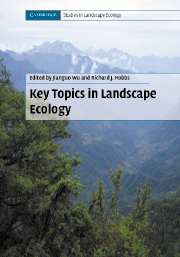Book contents
- Frontmatter
- Contents
- List of contributors
- Preface
- PART I Introduction
- PART II Key topics and perspectives
- 2 Adequate data of known accuracy are critical to advancing the field of landscape ecology
- 3 Landscape pattern analysis: key issues and challenges
- 4 Spatial heterogeneity and ecosystem processes
- 5 Landscape heterogeneity and metapopulation dynamics
- 6 Determining pattern–process relationships in heterogeneous landscapes
- 7 Scale and scaling: a cross-disciplinary perspective
- 8 Optimization of landscape pattern
- 9 Advances in detecting landscape changes at multiple scales: examples from northern Australia
- 10 The preoccupation of landscape research with land use and land cover
- 11 Applying landscape-ecological principles to regional conservation: the WildCountry Project in Australia
- 12 Using landscape ecology to make sense of Australia's last frontier
- 13 Transferring ecological knowledge to landscape planning: a design method for robust corridors
- 14 Integrative landscape research: facts and challenges
- PART III Synthesis
- Index
- References
2 - Adequate data of known accuracy are critical to advancing the field of landscape ecology
Published online by Cambridge University Press: 12 January 2010
- Frontmatter
- Contents
- List of contributors
- Preface
- PART I Introduction
- PART II Key topics and perspectives
- 2 Adequate data of known accuracy are critical to advancing the field of landscape ecology
- 3 Landscape pattern analysis: key issues and challenges
- 4 Spatial heterogeneity and ecosystem processes
- 5 Landscape heterogeneity and metapopulation dynamics
- 6 Determining pattern–process relationships in heterogeneous landscapes
- 7 Scale and scaling: a cross-disciplinary perspective
- 8 Optimization of landscape pattern
- 9 Advances in detecting landscape changes at multiple scales: examples from northern Australia
- 10 The preoccupation of landscape research with land use and land cover
- 11 Applying landscape-ecological principles to regional conservation: the WildCountry Project in Australia
- 12 Using landscape ecology to make sense of Australia's last frontier
- 13 Transferring ecological knowledge to landscape planning: a design method for robust corridors
- 14 Integrative landscape research: facts and challenges
- PART III Synthesis
- Index
- References
Summary
Introduction
The science of landscape ecology is especially dependent on high-quality data because often it focuses on broad-scale patterns and processes and deals in the long term. Likewise, high quality data are necessary as the basis for building policy. When issues, such as climate change, can induce international political and economic consequences, it becomes clear that providing high-quality, long-term data is paramount. It is not an accident that this chapter is positioned near the front of this book. Of the priority research topics presented in this book, this is the most pervasive across other topics because the availability of high-quality data limits progress in other realms. Be it historic land-use data needed to understand the dynamics of land-use change, the independent data of varying scales needed to assess scaling phenomena or test new metrics, the socioeconomic/cultural data needed to integrate humans into landscape ecology, or the biological and population data needed to evaluate ecological flows, the quality of raw data, metadata, and derived data products is critical to the core of landscape ecology. For each of these key topics and perspectives, the availability and quality of data will affect research results and practical recommendations.
Data advances in past two decades
It has been two decades since the 1983 workshop that many say established the landscape ecology field in North America (Risser et al. 1984).
- Type
- Chapter
- Information
- Key Topics in Landscape Ecology , pp. 11 - 38Publisher: Cambridge University PressPrint publication year: 2007
References
- 12
- Cited by

